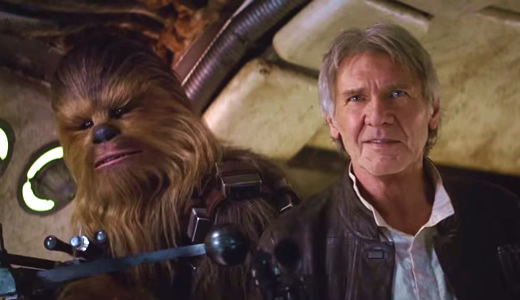In late May of 1977, my mom and I clambered into the cavernous back seat of our neighbors’ Chevrolet Caprice Classic wagon and headed downtown to see Star Wars at the palatial River Hills theater in Des Moines, Iowa. The opening scene is forever seared into my memory, and to this day I don’t think I’ve ever had an experience during a movie like the one I had when I was 6 watching Darth Vader’s Star Destroyer chase down Princess Leia’s fleeing blockade runner (the Tantive IV).
I wonder if Star Wars: The Force Awakens director J.J. Abrams may have had the same kind of experience. Why? Because the first scene of the second trailer toys with similar images, albeit with a twist. Once again, we witness a massive Star Destroyer and a smaller ship (this time, what appears to be an X-wing). Only there’s no pursuit this time around. That’s because they’re partially buried in the sands of, according to Abrams, the planet Jakku.
Those images, combined with John Williams’ iconic score (I think an argument could be made that it’s the most memorable movie music ever), set what little hair I have left standing on end.
And it just kept on standing: Luke Skywalker’s voice. Darth Vader’s mask. T.I.E. Fighters. The Millennium Falcon. And the coup de grace, Han Solo’s return lo these many years later, announcing, “Chewie, we’re home.” By the end, I was perilously close to tears—just like, apparently, Matthew McConaughey was …
And judging from my Facebook feed, Twitter, and, well, just about anywhere else you wanted to look in the online fanboy universe, I wasn’t the only one feeling that way.
What’s going on with a reaction like that?
In his Atlantic article “Star Wars: The Nostalgia Awakens,” David Sims says of these emotionally evocative images (and what they represent culturally), “It’s as if the blessed artifacts of the original films have been recovered by Abrams, an intrepid Hollywood archeologist who understands their power. By the time Harrison Ford delivers his one line (‘Chewie, we’re home’), Star Wars fans can’t help but feel moved, even if the emotional manipulation at work is obvious.”
Elsewhere, he adds:
“As my colleague Spencer Kornhaber noted of the film’s most recent trailer, there’s nothing going on here that audiences haven’t seen before. Familiar faces, stormtroopers, X-Wings swooping around, all set to John Williams’ score; this is the stuff of nostalgia, not the breath of fresh air the original Star Wars offered in 1977. Whatever new formula Abrams might be adding, it’s certainly not apparent from the advertising, which is instead designed to remind everyone of the first time they saw Han and Chewie in the Millennium Falcon.”
I think Sims and Kornhaber are right on the money here. Nostalgia is about more than merely remembering something. It’s about remembering what we felt when we experienced it. And few things have the power to instantly tap into nostalgia like the “blessed artifacts” of pop culture, be they beloved movies like Star Wars, or music, TV shows or video games that take us back to a time when perhaps we were feeling something powerful for the very first time.
Such is the force of nostalgia.






Recent Comments